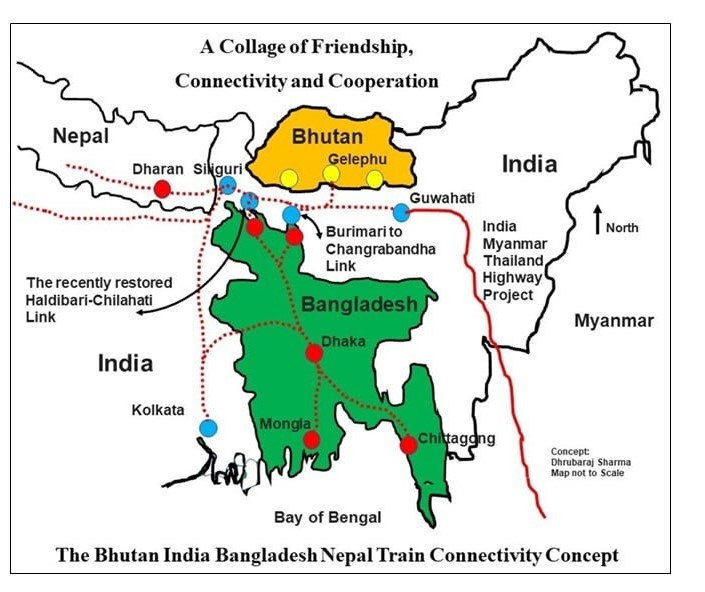Bangladesh and India have agreed to a landmark rail transit arrangement, allowing each country to use the other’s railway network for cross-border transportation of goods and passengers. This agreement extends to connections with Nepal and Bhutan as well.
Bangladesh Railway Director General Sardar Shahadat Ali and Ministry of Railways Secretary Humayun Kabir announced the details to the press on Wednesday. The arrangement stems from a memorandum of understanding (MoU) signed by Prime Minister Sheikh Hasina and her Indian counterpart Narendra Modi. A trial run on one of the proposed routes is scheduled for next month.
You Can Also Read: Bangladesh’s Voyage In Maritime Resource Management
The agreement outlines 12 potential routes, including a rail link between India and Bhutan via Bangladesh. Initial confusion regarding Bangladesh’s access to Bhutan and Nepal through Indian territory has been clarified; Bangladesh will indeed have this access.
While Bangladesh had previously signed transit agreements with Nepal and Bhutan in 1976 and 1984 respectively, these remained unutilized due to Indian reservations about allowing use of their land. The new arrangement overcomes this hurdle.

A proposed 1,275-km railway connecting India’s West Bengal with its seven northeastern states through Bangladesh would also benefit Bangladesh, allowing it to send cargo and passengers to Nepal, according to Indian media reports citing the country’s railway department.
For access to Bhutan, Bangladesh can use Indian rail tracks to reach West Bengal’s Hasimara Railway Station, just 18 kilometers from the southern Bhutanese border town of Phuntsholing.

Currently, five operational interchange points connect the rail networks of Bangladesh and India:
- Benapole (Bangladesh) – Petrapole (India)
- Darshana (Bangladesh) – Gede (India)
- Rohanpur (Bangladesh) – Singhabad (India)
- Birol (Bangladesh)—Radhikapur (India)
- Chilahati (Bangladesh) – Haldibari (India)
Trial runs have been conducted between Akhaura (Bangladesh) and Agartala (India), with commercial services expected to begin soon. Two additional rail connectivity projects are in the survey stage: Belonia (India) to Feni (Bangladesh) and Mahisasan (India) to Shahbazpur (Bangladesh).
Under the new agreement, India can operate trains on these routes using Bangladesh’s rail track, paying a fee to Bangladesh Railway. In the 2022-23 fiscal year, 982 Indian trains transported goods within Bangladesh, generating Tk117 crore in wagon charges for Bangladesh Railway.
This comprehensive agreement promises to enhance regional connectivity, facilitate trade, and promote economic cooperation among the participating countries.
How will Bangladesh benefit?
Experts assert that the new transit facility will allow trucks from Bangladesh to travel directly to Nepal and Bhutan through India, potentially boosting Bangladeshi exports to these countries. However, they emphasize the need for improved port infrastructure and roads to fully capitalize on these benefits.
Ahsan H Mansur, director of the Policy Research Institute of Bangladesh, states, “The transit proposal from India may not yield significant benefits with Bhutan, but Nepal presents great potential. We must seize this opportunity.” He suggests that implementing bilateral transit could increase rail transportation of goods, particularly through the Chilahati-Haldibari and Biral border areas. This could lead to establishing a direct rail link from Bangladesh’s northern districts to Nepal, in addition to expanding road trade.
Nepal has expressed interest in joining the rail link from Rohanpur in Bangladesh’s Chapainawabganj district via India. The distance to Kathmandu on this proposed railway is 217 kilometres.
Concurrently, China is constructing a railway from Lhasa in Tibet to Nepal’s border town of Khasa. Nepal aims to extend this route to Kathmandu. If realized, this could potentially allow trains from Bangladesh to reach China via Kathmandu.
The BBIN (Bangladesh, Bhutan, India, Nepal) agreement, signed in 2015, aims to facilitate free movement of traffic among these countries. While Bhutan has yet to ratify it, the other three nations have done so. This agreement provides for unrestricted movement of passenger and cargo vehicles, with protocols and operational rules already drafted.
India’s recent transit proposition has added a new dimension to this regional connectivity initiative, potentially enhancing trade and transportation links across the subcontinent.
Increased trade potentials with Nepal
As of now, Bangladesh’s leading land trade with Nepal is through the Banglabandha and Burimari borders of Panchagarh. The distance by road from Banglabandha to Kankarvita in Nepal is 39 kilometres. Due to the agreement with India, Bangladeshi goods-laden trucks can go directly to Nepal via that road.
Nepal was leading bilateral trade between Bangladesh and Nepal. However, the situation is now in Bangladesh’s favour. In the financial year 2021-22, Bangladesh exported goods worth about $5 crore to Nepal and imported products worth some $1.5 crore. Nepal has a population of about 30 million and an economy of $30 billion.
Abdus Salam Murshedy, former President of the Bangladesh Garments Manufacturers & Exporters Association (BGMEA), told the media that Bangladeshi ceramics, melamine, home textiles, furniture, terry towels, and clothing products are valuable in Nepal.
“Now, if the priority trade agreement with Nepal is completed, a new horizon will be introduced in the trade between the countries,” he said.
Bhutan has less to offer
Currently, Bangladesh has a trade deficit with Bhutan. The country signed its first Preferential Trade Agreement with Bhutan in December 2020 to reduce that deficit.
Under the agreement, 100 Bangladeshi products will be provided with a duty-free facility in Bhutan, while 34 Bhutanese products will be provided with a duty-free facility here. By doing this, the government hopes that trade relations between the two countries will increase.
The Bhutanese Embassy in Dhaka, through Bangladesh’s Ministry of Foreign Affairs, stated that the Bhutanese government has completed all internal preparations regarding the agreement and has proposed the implementation date to be March 01, 2024.


